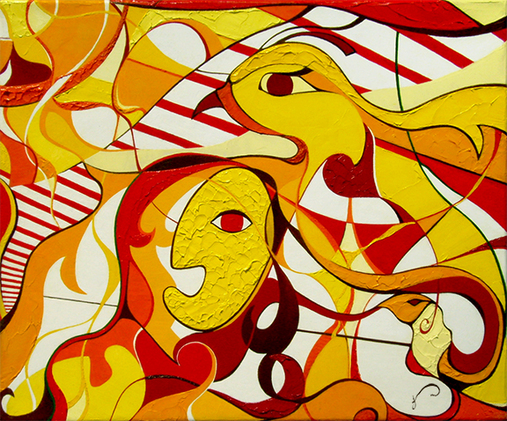|
Elements of time & space, string theory and deep ecology contributed in molding the concept of this piece. Painted entirely with a pallet knife.. A passage that helped inspire this composition...
"This symbol appears principally among the Gnostics and in the broadest sense, it is symbolic of time and of the continuity of life. It sometimes bears the caption Hen to pan - ' The One, the All,' as in the codex Marcianus, for instance, of the 2nd century A.D. It has also been explained as the union between the chthonian (underworld) signified by the bird ( a synthesis which can also be applied to the dragon). Ruland contends that this proves that it is a variant of the symbol for Mercury - the duplex god. In some versions of the Ouroboros, the body is half light and half dark, alluding in this way to the successive counterbalancing of opposing principles as illustrated in the Chinese Yang-Yin symbol for instance. Evola asserts that it represents the dissolution of the body or the universal serpent which ( to quote the Gnostic saying ) "passes through all things". Poison, the viper and the universal solvent are all symbols of the undifferentiated of the 'unchanging law' which moves through all things, linking them by a common bond... the ouroboros biting its own tail is symbolic of self-fecundation, or the primitive idea of a self-sufficient Nature - a Nature, that is, which a'la Nietzsche, continually returns, within a cyclic pattern, to its own beginning." |
How ''Ouroboros' came about...
|
|
This piece was commissioned by a lovely, number-crunching, French dame in Australia. She had taken a liking to a hand-pulled screen print I had done, and asked for an oil painting with a similar look , with a thoroughly original composition, of course. So the conceptual brainstorming and sketches commenced. The initial sketches were quite a mess, but here are a few of the final thumbnail sketches. Once I was happy with the final sketch I scanned it and then created a few colour studies on photoshop,..very useful when trying to visualize the final painting to a collector. Unlike the screenprint, I wanted to take advantage of the oil paints natural textural and impasto qualities. Using an impasto medium (Oleopasto) helped bulk up the paint and ensure a more stable thick layer (without the medium, thick oil paint might crack once dry). The entire painting was painted with a pallet knife with differing textural qualities throughout... |







